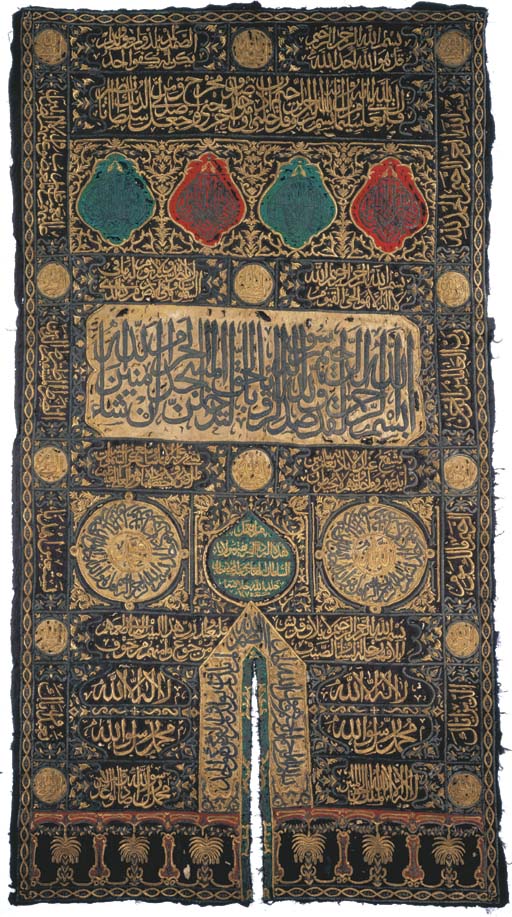

A Ka'aba curtain from 1858
Source: http://www.christies.com/LotFinder/search/LotDetail.asp?sid=&intObjectID=4483350&SE=CMWCAT03+629102+1904059171+&QR=M+1+45+Aqc0000900+611718++Aqc0000900+&entry=islamic&T=Lot&SU=1&RQ=True&AN=46
(downloaded Apr. 2005)
"THE EXTERNAL CURTAIN OF THE KA'BA DOOR (BURQA') WITH THE NAME OF ABDULMAJID I (ABDULMECID I), DATED AH 1275/1858 AD. Of rectangular form, embroidered in silver and silver-gilt thread over a black silk ground, the surface broken into cartouches of various shapes and sizes containing inscriptions in naskh and thuluth, the interstices filled with vegetal designs, a large silver inscription halfway up on cream ground, four red and green cartouches above containing mirrored calligraphic inscriptions below three roundels, one drop-shaped and containing the name of the sultan and date in gilt thread on green ground, flanked by one with name of Allah and another with the name of Muhammad, each surrounded by radial inscription in silver thread, beneath the central one an opening with calligraphic border, at the base a frieze of palm trees, the silver thread slightly oxidized, small tears in the silk, conserved, sleeve for hanging attached at top, rebacked. 181½ x 97½in. (465 x 250cm.).
Lot Notes: The Holy Ka'ba, The House of God (Bayt Allah) in the middle of the Masjid al-Haram (Grand Mosque) in Mecca is covered with a new kiswa each year on the 10th Dhul Hijja, coinciding with the Hajj. A tradition dating back to pre-Islamic times, its essential form and function has remained constant, though over the centuries much has changed in its detail and execution. In the time of the Prophet Muhammad and through to early 'Abbasid times it consisted simply of a plain white cloth. Nasr 'Abbasi 1160-1207 changed this to green and later to black, and from then on the tradition of using a black kiswa became fixed. The embroidered border, now so characteristic of the Kiswah, was only introduced in 1340 AD by the Bahri Mamluk ruler of Cairo, Sultan Hassan.
Throughout Mamluk times (7th-10th centuries AHH 13-16th centuries AD) it was made in workshops in Egypt, from whence it was carried on one of the major routes to Mecca. The following year, this cover was taken down, cut into pieces and its epigraphic panels either kept by the Sultan or given as gifts to the elite. After the conquest of Cairo in AH 923/1517 AD, the Ottoman Sultan, as Caliph, had the honour of dressing the Ka'ba, and it continued to be made in Egypt up to the early 14th century AH/20th century AD.
The fragments that are cut from the outgoing kiswa, especially the important ones such as the Burqa' which covers the portal or the Hizam (the strap border that almost encircles the square building about two thirds of the way up), are kept as prized relics. Since in Ottoman times they were mainly given to Ottoman courtiers or kept in the possession of the Sultan, understandably the Topkapi Sarayi in Istanbul retains the greatest collection of Ottoman-period kiswa fragments.
The present piece, the Burqa' ("Veil"), would have covered the portal to the cuboid structure. It is richly ornamented in silver and silver-gilt thread with almost every surface covered in inscriptions and a has only a small slit in the lower edge to allow access to the doorway.
The inscriptions are as follows: At the top, the basmalla and Qur'an CXII surat al-ikhlas, flanked by two roundels both containing the words Allah rabbi (Allah is my Lord), in the middle of the row on a third roundel is written Allah Hasbi(sufficient unto me is Allah).
On the second tier, starting from the top right corner, the basmalla, followed by Qur'an I surat al-fatiha, inscribed in consecutive parts that encircle the whole piece and the end at the upper left corner of the piece. The verses of surat al-fatiha are separated by the words Allah rabbi and Allah hasbi inscribed in small roundels.
The body of the piece is then divided into rows.
=First row: Qur'an XXVII surat, al-naml, v.30 and Qur'an XVII surat al-israa, v.80.
=Second row: four panels of coloured silk, two red and two green, each contain the basmalla, the left-half of each cartouche reflecting the right so the inscriptions read as symmetrical interlace designs.
=Third row : divided into two narrow panels. On the right hand is the basmalla and the first part of ayat al-kursi (The Throne Verse), (Qur'an II surat al-Baqara v.255). On the left side is the second part of ayat al-kursi, the two separated by a small roundel inscribed with the words Allah hasbi .
=Fourth row: a broad panel containing Qur'an XLVIII surat al-fath, v.27
=The fifth row is also divided into two parts that contain the rest of ayat al-kursi, separated by a circle inscribed Allah hasbi.
=Sixth row: divided into three squares. On the right is a large roundel, in the centre of which is the word Allah, radiating the basmalla and Qur'an CCXII surat al-ikhlas. This is balanced on the left side by a similar roundel, this time with the word Muhammad radiating the basmallah and surat al-ikhlas. Between the two is a green drop-shaped cartouche, inscribed with the words, "This cover was ordered by our lord, Sultan, the Conqueror, 'Abd al-Majid Khan, May Allah perpetuate his Caliphate, in the year 1275 AH"
=Seventh row: two parts separated by the opening for the portal. On the right side is the basmalla and the first part of Qur'an CVI surat quaraish, which continues on the left part. The eighth, ninth and tenth rows are similarly divided by the opening. Both sides of the eighth and ninth rows give the shahada , while the ninth row reads on the right "There is no God but Allah, The Supreme Power, The Lucid" and on the left side "Muhammad is the Messenger of Allah, The Truthful, The Faithful"."